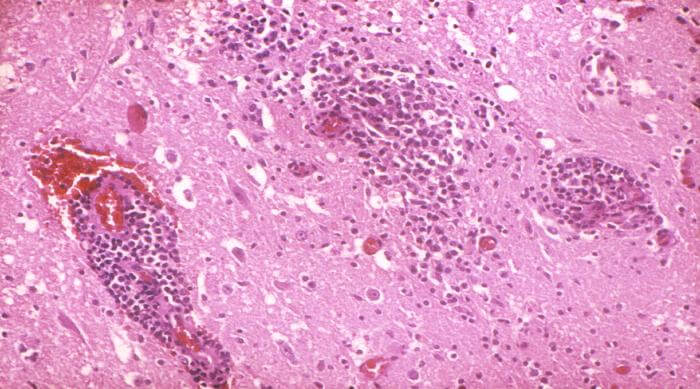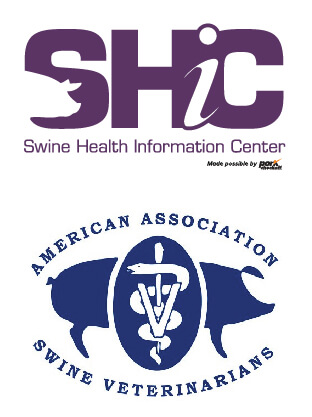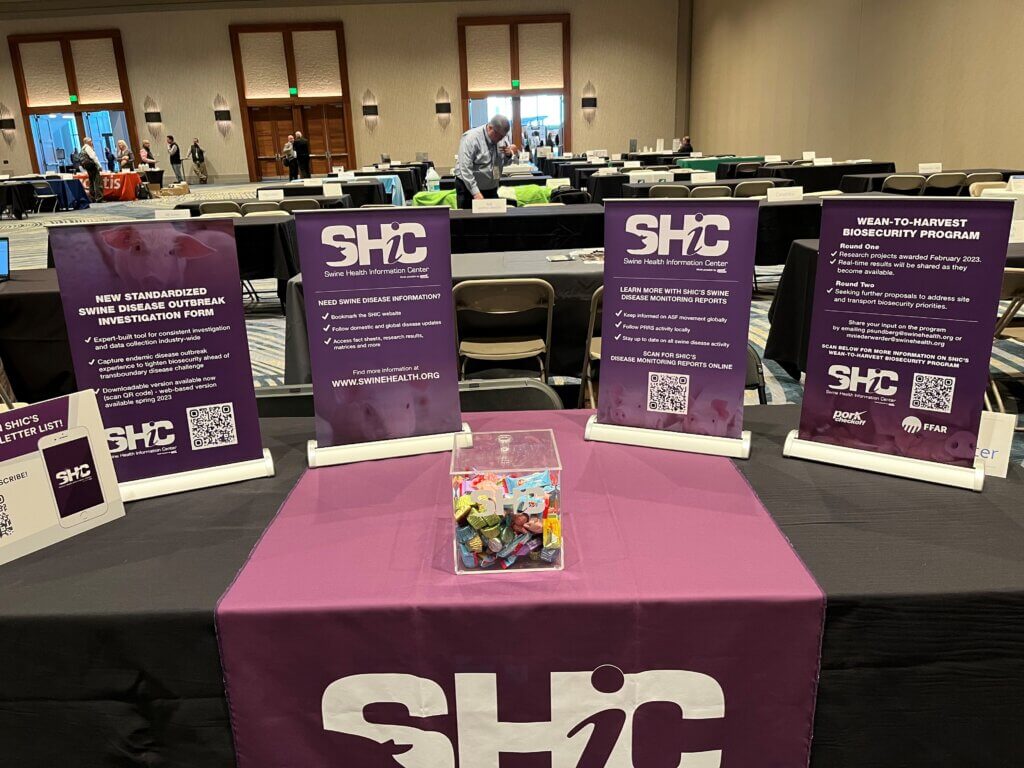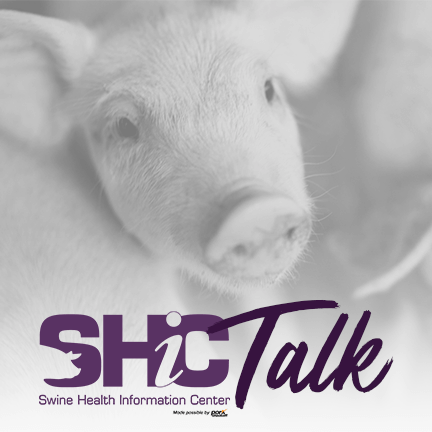
SHIC, launched by the National Pork Board in 2015 solely with Pork Checkoff funding, continues to focus efforts on prevention, preparedness, and response to novel and emerging swine disease for the benefit of US swine health. As a conduit of information and research, SHIC encourages sharing of its publications and research. Forward, reprint, and quote SHIC material freely. SHIC is funded by America’s pork producers to fulfill its mission to protect and enhance the health of the US swine herd. For more information, visit http://www.swinehealth.org or contact Dr. Sundberg at [email protected].

The Swine Health Information Center is soliciting a second round of proposals for its Wean-to-Harvest Biosecurity Program with funding from the Center, the Foundation for Food & Agriculture Research, and Pork Checkoff. The program proactively enhances wean-to-harvest biosecurity to help control the next emerging disease in the US pork industry and improve US swine herd health.
“As a veterinarian, I am constantly tasked with, asked about, and challenged on biosecurity processes or protocols – what is the ‘right’ way, what is the value or ROI, what is the science behind this, does this even work?” commented Jeremy Pittman, DVM, senior director of US veterinary services for Smithfield Foods and SHIC board member. “While there has been a lot of good scientific biosecurity work reported, we need more to answer these and other questions more confidently and to get better as an industry.”
The first round of research proposals was funded in February 2023. This second round of research will investigate cost-effective and innovative technologies, protocols, or ideas to develop solutions for biosecurity gaps that were not adequately addressed in the first round of projects. Approximately $1.3 million is available for this second round of research.
“The swine industry has traditionally focused on breeding herds, boar studs, and live haul transportation for much of the biosecurity work. But recently, grow-out sites and market haul transportation have started to get more attention in response to both domestic and foreign animal disease prevention and mitigation,” Dr. Pittman remarked. “This type of focused research will help the industry continue to get better and for biosecurity practices to be more effective and efficient.”
The updated research priorities in the second round of solicitation continue to focus on site and transportation biosecurity. They cover five targeted areas: 1) personnel biocontainment and bioexclusion, 2) mortality management, 3) truck wash efficiency, 4) alternatives to fixed truck wash, and 5) packing plant biocontainment. “We are seeking novel tools in any of the five areas to help result in comprehensive biosecurity enhancement,” remarked SHIC Executive Director Dr. Paul Sundberg.
The call for proposals encourages collaborative projects including pork industry, allied industry and/or academic public/private partnerships, demonstrating the most urgency and timeliness of completion, and showing high value to pork producers with efficient use of funds. Proposals are due by 5 p.m. CDT, April 28, 2023. SHIC, FFAR and Pork Checkoff anticipate release of all research project results as they are made available.
The Wean-to-Harvest Biosecurity Program aligns with SHIC’s mission to analyze swine health data and support targeted research to benefit the US pork industry. SHIC-funded Swine Disease Monitoring Reports’ aggregate data show breeding herd breaks of porcine reproductive and respiratory syndrome virus and porcine epidemic diarrhea virus tend to follow breaks in wean-to-harvest sites. A SHIC-funded project detailed how PRRS and PED negative pigs placed on wean-to-harvest sites become infected after placement. SHIC’s Rapid Response Program investigation of the Actinobacillus pleuropneumoniae outbreak in the Midwest exposed deficiencies of wean-to-harvest biosecurity that contributed to disease spread.
Foundation for Food & Agriculture Research
The Foundation for Food & Agriculture Research (FFAR) builds public-private partnerships to fund bold research addressing big food and agriculture challenges. FFAR was established in the 2014 Farm Bill to increase public agriculture research investments, fill knowledge gaps and complement U.S. Department of Agriculture’s research agenda. FFAR’s model matches federal funding from Congress with private funding, delivering a powerful return on taxpayer investment. Through collaboration and partnerships, FFAR advances actionable science benefiting farmers, consumers and the environment. Connect: @FoundationFAR

The February 2022 outbreak of Japanese encephalitis virus in Australia spurred action by animal and public health officials around the world. In the US, the pork industry began monitoring Australia’s situation and response, ramping up prevention and preparedness activities immediately. The Swine Health Information Center, along with industry partners, compiled a comprehensive list of research gaps to facilitate next steps in the ongoing efforts towards reducing the risk of JEV introduction and spread, understanding JEV’s impact on production, and investigating how on-farm factors influence JEV transmission.
An October 2022 JEV symposium co-sponsored by SHIC helped to inform the research gap identification effort, with needs broken into three areas of focus: immediate preparation response, intermediate response, and longer-term response. Review the full list of priorities here.
Immediate preparation/response
Production loss. Investigate trade implications of a JEV incursion into the US; estimate the potential economic losses to the US pork industry due to production losses on sow farms, disrupted domestic and international markets, and trade restrictions if JEV is introduced.
Epidemiology. Investigate the mechanism of JEV spread through a production site, defining the risks or epidemiological factors, including vector-free transmission, playing a role in the extent of spread and variation of clinical signs within a litter and across litters. Goals include identifying mitigation strategies to minimize JEV impact on farm production.
Diagnostics. Design novel, or confirm current, diagnostic assays for JEV (PCR, antibody) at US veterinary diagnostic laboratories can distinguish between other flaviviruses in the US (West Nile virus, St Louis encephalitis virus) and will detect all five genotypes (I-V) of JEV.
Eradication. Model spatiotemporal spread of JEV post-incursion to identify mitigation strategies for biocontainment and rapid eradication from the US.
Communication. Determine the most effective consumer and producer messaging on JEV being a “mosquito disease,” with the goal of minimizing negative effects on pork production and consumption while maximizing safety and protection of swine personnel in the event of JEV incursion.
Intermediate response
Surveillance. Investigate surveillance targets (species, high risk locations in US, sample types) and diagnostic assays (PCR, antibody) to develop an effective surveillance plan for earliest detection of a JEV incursion into the US.
Compatible cases. Investigate syndromic surveillance for case compatible VDL submissions in the US of reproductive disease from sow farms (abortions, mummified fetuses, stillborns, neonatal tremors) to define the annual or seasonal number of compatible cases, including the percent of cases in which no definitive diagnosis is determined.
Challenge model. Develop experimental challenge models for JEV to interrogate interventions and their effect on clinical disease severity, pathogenesis in pregnant sows, transmission rates, virus replication, and prevalence within and across litters.
Longer term response
Vaccines. Develop vaccine candidates for use in US commercial swine, to minimize production losses if JEV is introduced, that could be deployed post-outbreak and would allow differentiation of vaccinated from infected animals.
Cross-protection. Determine the extent of JEV cross-protection that is present in US commercial swine after exposure to other flaviviruses (WNV, SLEV) endemic to the US.
Mosquito control. Investigate effective mosquito control measures for swine farms in the US, including recommendations based on site design, ventilation type, and manure storage.
Vectors. Investigate and characterize the competence of potential vector host species in the US for JEV, including their geographic proximity to feral and commercial swine populations, and propensity to feed on pigs or ardeid birds.
Wildlife. Define the risk and mitigation of known wildlife hosts, such as feral swine and ardeid birds, in the role of JEV introduction and spread to commercial swine in the US.
Novel hosts. Investigate and characterize the competence of novel vertebrate host species (non-ardeids and non-swine) in the US to act as amplifying or dead-end hosts of JEV, including their geographic distribution and proximity to commercial or feral swine.
Sequencing. Investigate the molecular pathogenesis differences between genotype 4 and historical JEV genotypes, including an estimation of virulence factors based on whole genome sequencing.
SHIC is working with industry, university, and federal partners to address these research needs and enhance the ability of the US swine industry to prevent, prepare, and respond to JEV if introduced. As part of this process, SHIC is in communication with Australian veterinarians, producers, and researchers to discuss opportunities for JEV collaboration.
This list of research priorities builds on SHIC’s currently funded JEV preparedness efforts, including an updated JEV entry and establishment risk assessment, a comprehensive JEV literature review, and a JEV Information Sharing Network website. This new website will be a JEV information resource designed to answer the pork industry’s immediate questions and needs if JEV is introduced into the US. As research efforts progress, results will be shared by SHIC and posted on the SHIC website as soon as they become available.

Consistent with the Swine Health Information Center’s mission to protect and enhance the health of the United States swine herd, it strives to share information and resources with those on the front lines of the swine health battle. At the recent American Association of Swine Veterinarians Annual Meeting, SHIC-funded research and programs were shared to help practitioners serve their producer customers with the latest tools for swine disease prevention, preparedness, and response. This information is also made available through other communications channels.
During the AASV Annual Meeting, SHIC’s Tech Table provided attendees with information about the new standardized outbreak investigation instrument, domestic and global disease monitoring reports, Wean-to-Harvest Biosecurity Program, and more. SHIC also directed practitioners to resources included on the website and encouraged attendees to sign up for the monthly enewsletter.
Presentations and papers in the AASV Annual Meeting Proceedings detailing swine health research with SHIC-related support include:
“PCR detection of ASFV nucleic acid in oral swabs from clinical and nonclinical sows of three swine farms in Vietnam”
“An update on activities of the ASF working group for boar stud business continuity during an outbreak”
“Bayesian latent class analysis of the sensitivity and specificity of a novel PCR and indirect ELISA for African swine fever virus antibody”
“Progression of the newly emerged PRRSV L1C 144 variant in breeding herds”
The SHIC-supported MSHMP and Swine Disease Reporting System were also highlighted in the AASV proceedings as industry resources for identifying endemic disease trends, such as seasonality, benchmarking, and prevalence across production phases. Papers referencing MSHMP and/or SDRS data include “PRRS: The fight continues” (Carthage Veterinary Service), “Adsorption of PRRS virus strains to Minnesota soils, a possible transmission route” (University of Minnesota), and “The time is now to eliminate porcine epidemic diarrhea virus” (Swine Vet Center).
SHIC’s Rapid Response Team was highlighted as a resource for outbreak investigations and hazard data analysis in AASV proceedings papers including “An outbreak investigation of Actinobacillus pleuropneumoniae serotype 15 in Iowa in 2021-22” (Iowa State University, et al.) and “Biosecurity from 30,000 feet: Web-based platforms enabling an epidemiological perspective (above the trees to see the forest)” (Pig Improvement Company, et al.). And SHIC’s Wean-to-Harvest Biosecurity Research Program to enhance grow/finish site and transport biosecurity was referenced in the proceedings entitled “Biosecurity: Why do we do it and who do we do it for?” (Suidae Health & Production).


A new standardized outbreak investigation instrument is now available on the SHIC website. SHIC Executive Director Dr Paul Sundberg and Associate Director Dr Megan Niederwerder talk with Iowa State University College of Veterinary Medicine Dr Derald Holtkamp about creation of the new instrument now available for download and use from the SHIC website and plans for an online version to be available in late spring 2023.

This month’s Domestic Swine Disease Monitoring Report brings information about the continued detection of PRRSV Lineage 1C variant of RFLP 1-4-4 in eastern US states (Indiana and Pennsylvania) and detections from sow farms in Oklahoma. For enteric coronaviruses, PDCoV positivity was above the expected in March, and the SDRS detected cycles of increased PDCoV activity occurring every two years; TGEV completed two years without RT-PCR detection (83,323 cases tested). Regarding PCV2, there was a marked increase in PCR positivity in the adult/sow farm category. In addition, PCV2 is in the top 10 pathogens detected in the confirmed disease diagnosis. In the podcast, SDRS hosts talk with Dr. Maria Clavijo about Streptococcus suis dynamics, diagnostic process, and interventions to control the clinical expression of this pathogen.

A new African swine fever surveillance strategy has been launched in the Dominican Republic. The new regulation sets mandatory sampling every 21 days. In Russia, about 16 tonnes of meat products were confiscated and destroyed in a meat processing plant after detecting ASF in a routine inspection. In China, a new ASF surge after the new year is set to reduce hog output and push up market prices. National authorities communicated that the entire Colombian territory is certified as free of foot-and-mouth disease by the World Organization for Animal Health.
Also in this month’s report, read about UK surveillance efforts discovering one tonne of smuggled pork, seized in Suffolk, since November 2022.
Copyright 2025 | Swinehealth.org | Website by Heartland Marketing Group